Employment Law Case Study: Analyzing Annie's Legal Claim
VerifiedAdded on 2023/06/14
|10
|2559
|269
Case Study
AI Summary
This case study examines whether Annie has a legal claim against Will following an injury caused by Tom, focusing on the principles of vicarious liability and the distinction between an employee and an independent contractor. The analysis applies legal tests such as the control test, integration test, and multiple factor test derived from relevant case law like Yewens v Noakes and Ready Mixed Concrete (South East) Ltd v Minister of Pensions and National Insurance to determine Tom's employment status. The study concludes that based on the provided facts, Tom is likely an independent contractor due to his use of his own equipment, registered business, and the lack of regular remuneration, thus Will may not be vicariously liable for Tom's actions. The case study refers to Prince Alfred College Incorporated v ADC which provides that provisions of vicarious liability are only applicable when it is proved that the person who has indulged induction is under the control of the employer. Desklib offers similar solved assignments and past papers for students.
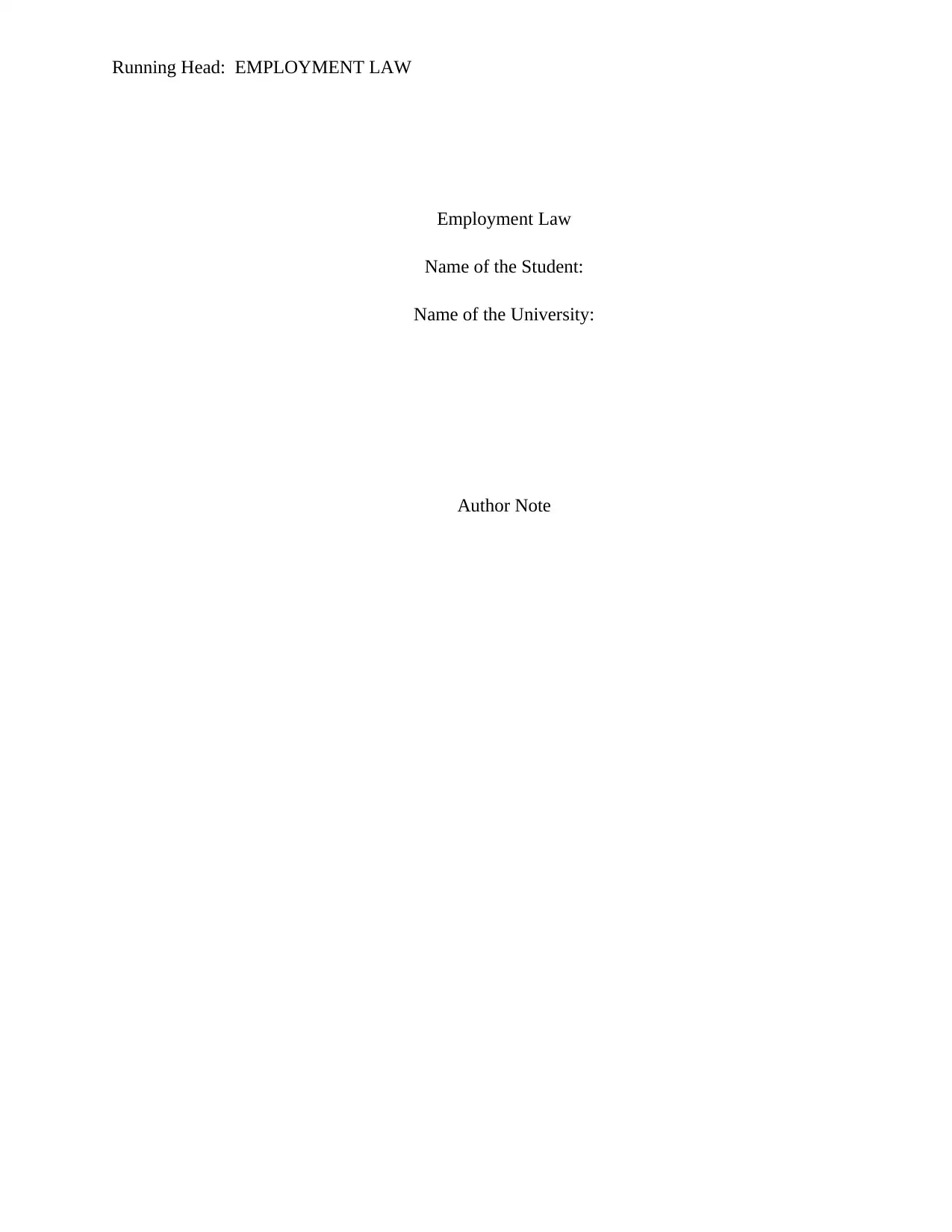
Running Head: EMPLOYMENT LAW
Employment Law
Name of the Student:
Name of the University:
Author Note
Employment Law
Name of the Student:
Name of the University:
Author Note
Paraphrase This Document
Need a fresh take? Get an instant paraphrase of this document with our AI Paraphraser
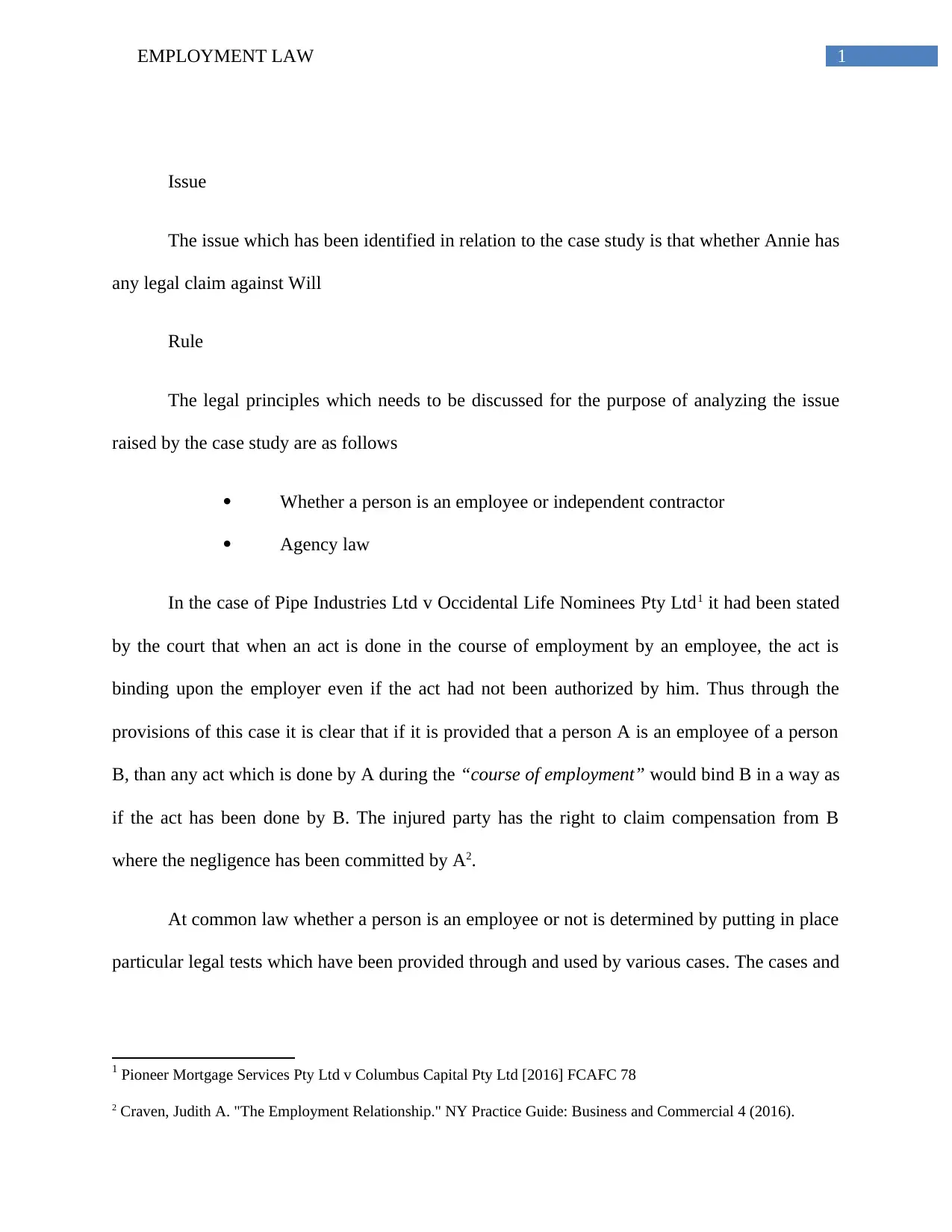
1EMPLOYMENT LAW
Issue
The issue which has been identified in relation to the case study is that whether Annie has
any legal claim against Will
Rule
The legal principles which needs to be discussed for the purpose of analyzing the issue
raised by the case study are as follows
Whether a person is an employee or independent contractor
Agency law
In the case of Pipe Industries Ltd v Occidental Life Nominees Pty Ltd1 it had been stated
by the court that when an act is done in the course of employment by an employee, the act is
binding upon the employer even if the act had not been authorized by him. Thus through the
provisions of this case it is clear that if it is provided that a person A is an employee of a person
B, than any act which is done by A during the “course of employment” would bind B in a way as
if the act has been done by B. The injured party has the right to claim compensation from B
where the negligence has been committed by A2.
At common law whether a person is an employee or not is determined by putting in place
particular legal tests which have been provided through and used by various cases. The cases and
1 Pioneer Mortgage Services Pty Ltd v Columbus Capital Pty Ltd [2016] FCAFC 78
2 Craven, Judith A. "The Employment Relationship." NY Practice Guide: Business and Commercial 4 (2016).
Issue
The issue which has been identified in relation to the case study is that whether Annie has
any legal claim against Will
Rule
The legal principles which needs to be discussed for the purpose of analyzing the issue
raised by the case study are as follows
Whether a person is an employee or independent contractor
Agency law
In the case of Pipe Industries Ltd v Occidental Life Nominees Pty Ltd1 it had been stated
by the court that when an act is done in the course of employment by an employee, the act is
binding upon the employer even if the act had not been authorized by him. Thus through the
provisions of this case it is clear that if it is provided that a person A is an employee of a person
B, than any act which is done by A during the “course of employment” would bind B in a way as
if the act has been done by B. The injured party has the right to claim compensation from B
where the negligence has been committed by A2.
At common law whether a person is an employee or not is determined by putting in place
particular legal tests which have been provided through and used by various cases. The cases and
1 Pioneer Mortgage Services Pty Ltd v Columbus Capital Pty Ltd [2016] FCAFC 78
2 Craven, Judith A. "The Employment Relationship." NY Practice Guide: Business and Commercial 4 (2016).
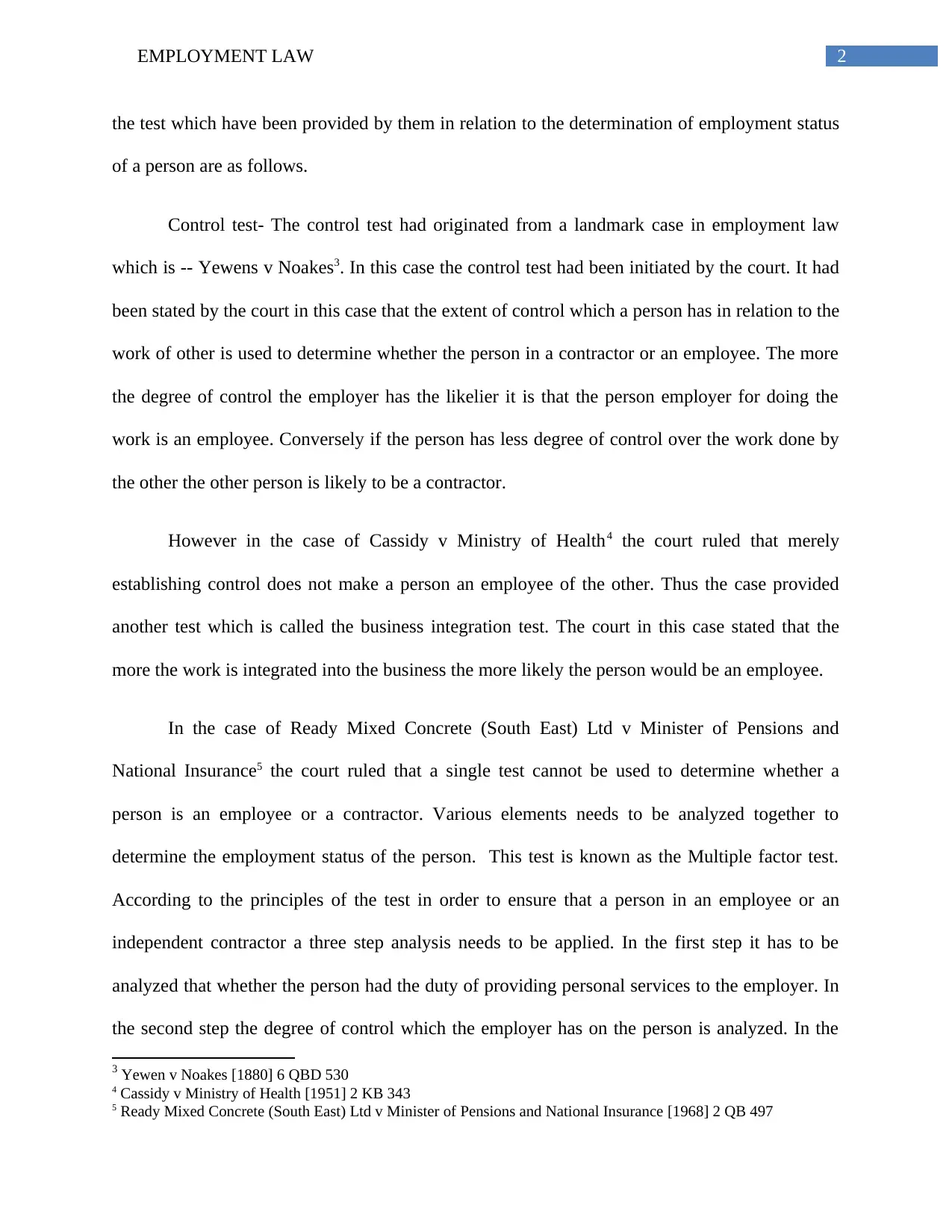
2EMPLOYMENT LAW
the test which have been provided by them in relation to the determination of employment status
of a person are as follows.
Control test- The control test had originated from a landmark case in employment law
which is -- Yewens v Noakes3. In this case the control test had been initiated by the court. It had
been stated by the court in this case that the extent of control which a person has in relation to the
work of other is used to determine whether the person in a contractor or an employee. The more
the degree of control the employer has the likelier it is that the person employer for doing the
work is an employee. Conversely if the person has less degree of control over the work done by
the other the other person is likely to be a contractor.
However in the case of Cassidy v Ministry of Health4 the court ruled that merely
establishing control does not make a person an employee of the other. Thus the case provided
another test which is called the business integration test. The court in this case stated that the
more the work is integrated into the business the more likely the person would be an employee.
In the case of Ready Mixed Concrete (South East) Ltd v Minister of Pensions and
National Insurance5 the court ruled that a single test cannot be used to determine whether a
person is an employee or a contractor. Various elements needs to be analyzed together to
determine the employment status of the person. This test is known as the Multiple factor test.
According to the principles of the test in order to ensure that a person in an employee or an
independent contractor a three step analysis needs to be applied. In the first step it has to be
analyzed that whether the person had the duty of providing personal services to the employer. In
the second step the degree of control which the employer has on the person is analyzed. In the
3 Yewen v Noakes [1880] 6 QBD 530
4 Cassidy v Ministry of Health [1951] 2 KB 343
5 Ready Mixed Concrete (South East) Ltd v Minister of Pensions and National Insurance [1968] 2 QB 497
the test which have been provided by them in relation to the determination of employment status
of a person are as follows.
Control test- The control test had originated from a landmark case in employment law
which is -- Yewens v Noakes3. In this case the control test had been initiated by the court. It had
been stated by the court in this case that the extent of control which a person has in relation to the
work of other is used to determine whether the person in a contractor or an employee. The more
the degree of control the employer has the likelier it is that the person employer for doing the
work is an employee. Conversely if the person has less degree of control over the work done by
the other the other person is likely to be a contractor.
However in the case of Cassidy v Ministry of Health4 the court ruled that merely
establishing control does not make a person an employee of the other. Thus the case provided
another test which is called the business integration test. The court in this case stated that the
more the work is integrated into the business the more likely the person would be an employee.
In the case of Ready Mixed Concrete (South East) Ltd v Minister of Pensions and
National Insurance5 the court ruled that a single test cannot be used to determine whether a
person is an employee or a contractor. Various elements needs to be analyzed together to
determine the employment status of the person. This test is known as the Multiple factor test.
According to the principles of the test in order to ensure that a person in an employee or an
independent contractor a three step analysis needs to be applied. In the first step it has to be
analyzed that whether the person had the duty of providing personal services to the employer. In
the second step the degree of control which the employer has on the person is analyzed. In the
3 Yewen v Noakes [1880] 6 QBD 530
4 Cassidy v Ministry of Health [1951] 2 KB 343
5 Ready Mixed Concrete (South East) Ltd v Minister of Pensions and National Insurance [1968] 2 QB 497
⊘ This is a preview!⊘
Do you want full access?
Subscribe today to unlock all pages.

Trusted by 1+ million students worldwide
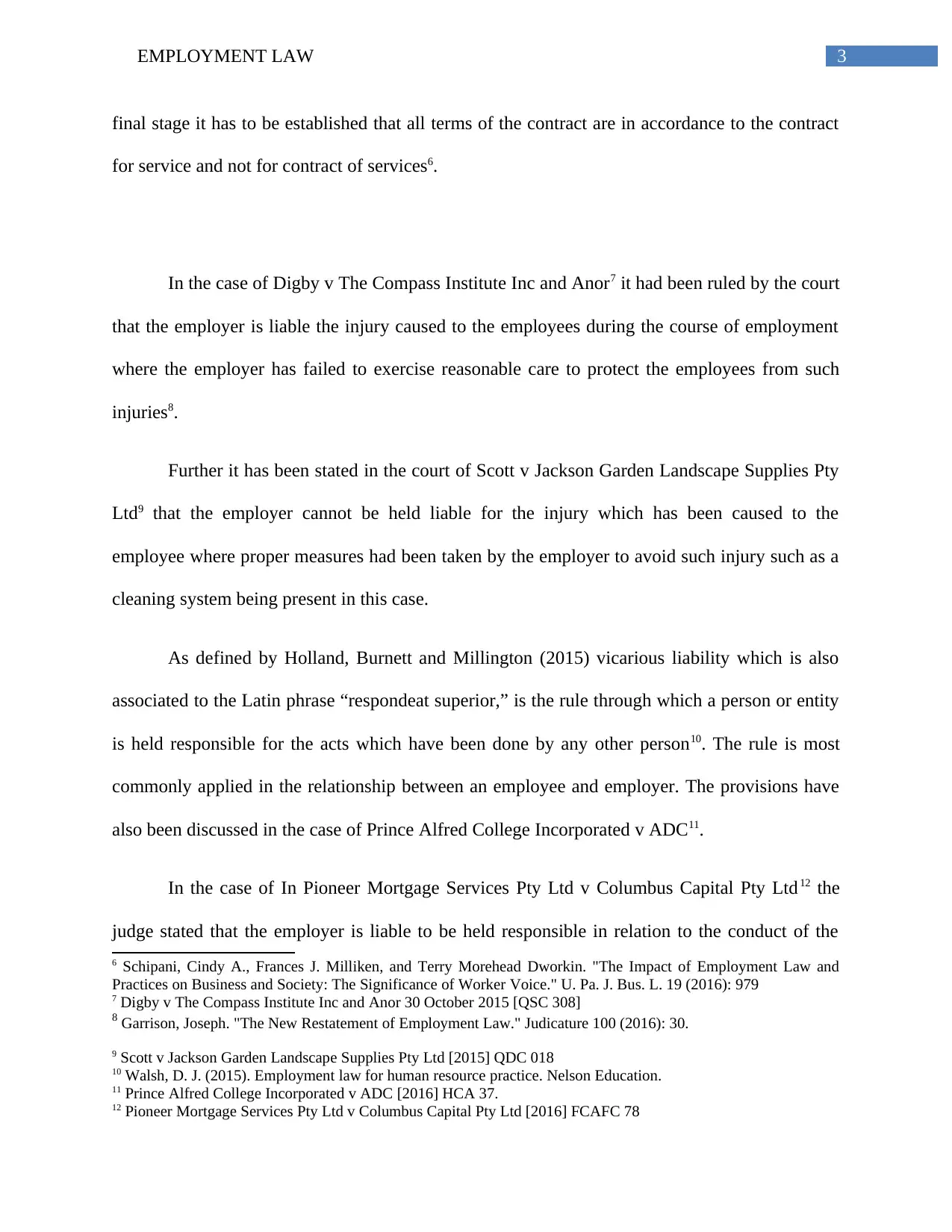
3EMPLOYMENT LAW
final stage it has to be established that all terms of the contract are in accordance to the contract
for service and not for contract of services6.
In the case of Digby v The Compass Institute Inc and Anor7 it had been ruled by the court
that the employer is liable the injury caused to the employees during the course of employment
where the employer has failed to exercise reasonable care to protect the employees from such
injuries8.
Further it has been stated in the court of Scott v Jackson Garden Landscape Supplies Pty
Ltd9 that the employer cannot be held liable for the injury which has been caused to the
employee where proper measures had been taken by the employer to avoid such injury such as a
cleaning system being present in this case.
As defined by Holland, Burnett and Millington (2015) vicarious liability which is also
associated to the Latin phrase “respondeat superior,” is the rule through which a person or entity
is held responsible for the acts which have been done by any other person10. The rule is most
commonly applied in the relationship between an employee and employer. The provisions have
also been discussed in the case of Prince Alfred College Incorporated v ADC11.
In the case of In Pioneer Mortgage Services Pty Ltd v Columbus Capital Pty Ltd12 the
judge stated that the employer is liable to be held responsible in relation to the conduct of the
6 Schipani, Cindy A., Frances J. Milliken, and Terry Morehead Dworkin. "The Impact of Employment Law and
Practices on Business and Society: The Significance of Worker Voice." U. Pa. J. Bus. L. 19 (2016): 979
7 Digby v The Compass Institute Inc and Anor 30 October 2015 [QSC 308]
8 Garrison, Joseph. "The New Restatement of Employment Law." Judicature 100 (2016): 30.
9 Scott v Jackson Garden Landscape Supplies Pty Ltd [2015] QDC 018
10 Walsh, D. J. (2015). Employment law for human resource practice. Nelson Education.
11 Prince Alfred College Incorporated v ADC [2016] HCA 37.
12 Pioneer Mortgage Services Pty Ltd v Columbus Capital Pty Ltd [2016] FCAFC 78
final stage it has to be established that all terms of the contract are in accordance to the contract
for service and not for contract of services6.
In the case of Digby v The Compass Institute Inc and Anor7 it had been ruled by the court
that the employer is liable the injury caused to the employees during the course of employment
where the employer has failed to exercise reasonable care to protect the employees from such
injuries8.
Further it has been stated in the court of Scott v Jackson Garden Landscape Supplies Pty
Ltd9 that the employer cannot be held liable for the injury which has been caused to the
employee where proper measures had been taken by the employer to avoid such injury such as a
cleaning system being present in this case.
As defined by Holland, Burnett and Millington (2015) vicarious liability which is also
associated to the Latin phrase “respondeat superior,” is the rule through which a person or entity
is held responsible for the acts which have been done by any other person10. The rule is most
commonly applied in the relationship between an employee and employer. The provisions have
also been discussed in the case of Prince Alfred College Incorporated v ADC11.
In the case of In Pioneer Mortgage Services Pty Ltd v Columbus Capital Pty Ltd12 the
judge stated that the employer is liable to be held responsible in relation to the conduct of the
6 Schipani, Cindy A., Frances J. Milliken, and Terry Morehead Dworkin. "The Impact of Employment Law and
Practices on Business and Society: The Significance of Worker Voice." U. Pa. J. Bus. L. 19 (2016): 979
7 Digby v The Compass Institute Inc and Anor 30 October 2015 [QSC 308]
8 Garrison, Joseph. "The New Restatement of Employment Law." Judicature 100 (2016): 30.
9 Scott v Jackson Garden Landscape Supplies Pty Ltd [2015] QDC 018
10 Walsh, D. J. (2015). Employment law for human resource practice. Nelson Education.
11 Prince Alfred College Incorporated v ADC [2016] HCA 37.
12 Pioneer Mortgage Services Pty Ltd v Columbus Capital Pty Ltd [2016] FCAFC 78
Paraphrase This Document
Need a fresh take? Get an instant paraphrase of this document with our AI Paraphraser
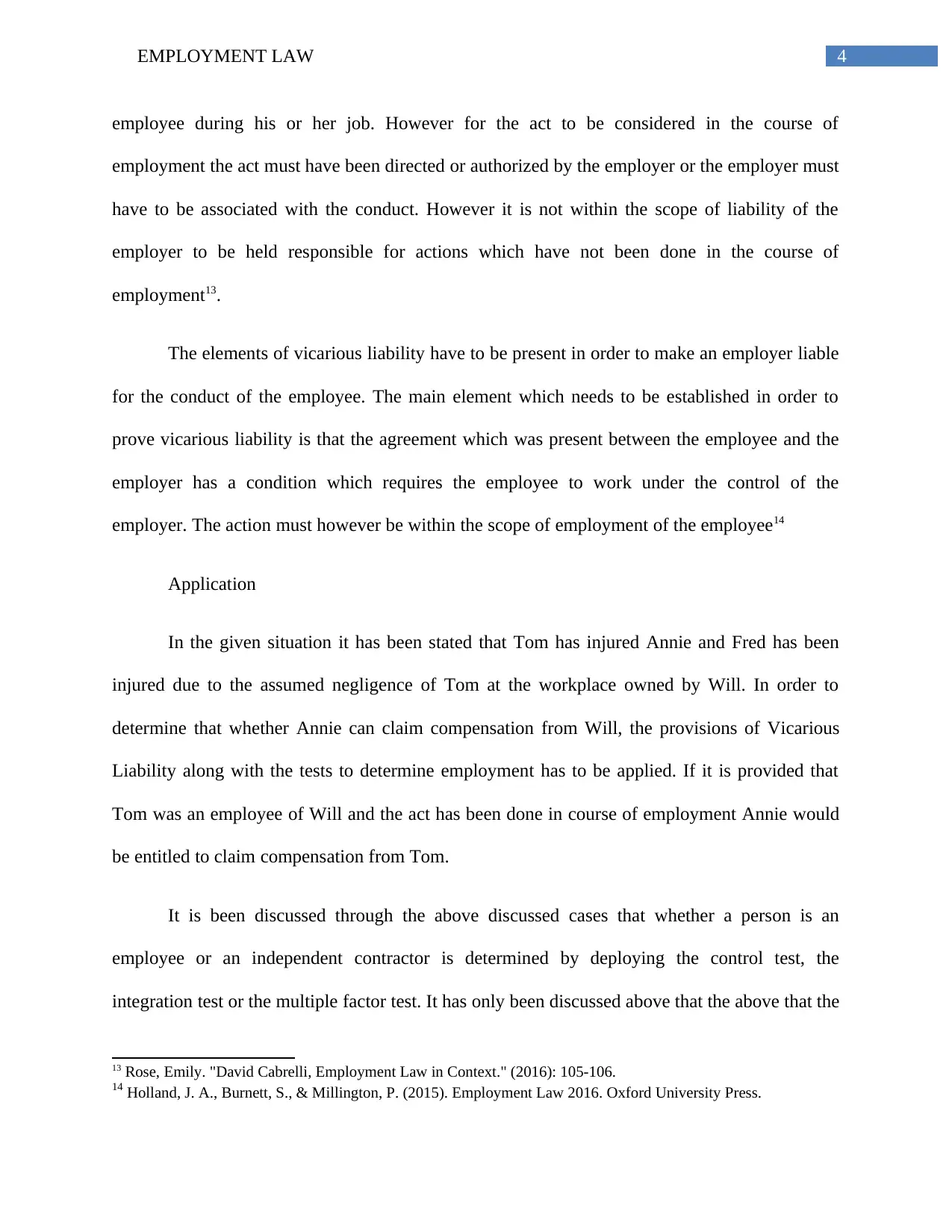
4EMPLOYMENT LAW
employee during his or her job. However for the act to be considered in the course of
employment the act must have been directed or authorized by the employer or the employer must
have to be associated with the conduct. However it is not within the scope of liability of the
employer to be held responsible for actions which have not been done in the course of
employment13.
The elements of vicarious liability have to be present in order to make an employer liable
for the conduct of the employee. The main element which needs to be established in order to
prove vicarious liability is that the agreement which was present between the employee and the
employer has a condition which requires the employee to work under the control of the
employer. The action must however be within the scope of employment of the employee14
Application
In the given situation it has been stated that Tom has injured Annie and Fred has been
injured due to the assumed negligence of Tom at the workplace owned by Will. In order to
determine that whether Annie can claim compensation from Will, the provisions of Vicarious
Liability along with the tests to determine employment has to be applied. If it is provided that
Tom was an employee of Will and the act has been done in course of employment Annie would
be entitled to claim compensation from Tom.
It is been discussed through the above discussed cases that whether a person is an
employee or an independent contractor is determined by deploying the control test, the
integration test or the multiple factor test. It has only been discussed above that the above that the
13 Rose, Emily. "David Cabrelli, Employment Law in Context." (2016): 105-106.
14 Holland, J. A., Burnett, S., & Millington, P. (2015). Employment Law 2016. Oxford University Press.
employee during his or her job. However for the act to be considered in the course of
employment the act must have been directed or authorized by the employer or the employer must
have to be associated with the conduct. However it is not within the scope of liability of the
employer to be held responsible for actions which have not been done in the course of
employment13.
The elements of vicarious liability have to be present in order to make an employer liable
for the conduct of the employee. The main element which needs to be established in order to
prove vicarious liability is that the agreement which was present between the employee and the
employer has a condition which requires the employee to work under the control of the
employer. The action must however be within the scope of employment of the employee14
Application
In the given situation it has been stated that Tom has injured Annie and Fred has been
injured due to the assumed negligence of Tom at the workplace owned by Will. In order to
determine that whether Annie can claim compensation from Will, the provisions of Vicarious
Liability along with the tests to determine employment has to be applied. If it is provided that
Tom was an employee of Will and the act has been done in course of employment Annie would
be entitled to claim compensation from Tom.
It is been discussed through the above discussed cases that whether a person is an
employee or an independent contractor is determined by deploying the control test, the
integration test or the multiple factor test. It has only been discussed above that the above that the
13 Rose, Emily. "David Cabrelli, Employment Law in Context." (2016): 105-106.
14 Holland, J. A., Burnett, S., & Millington, P. (2015). Employment Law 2016. Oxford University Press.
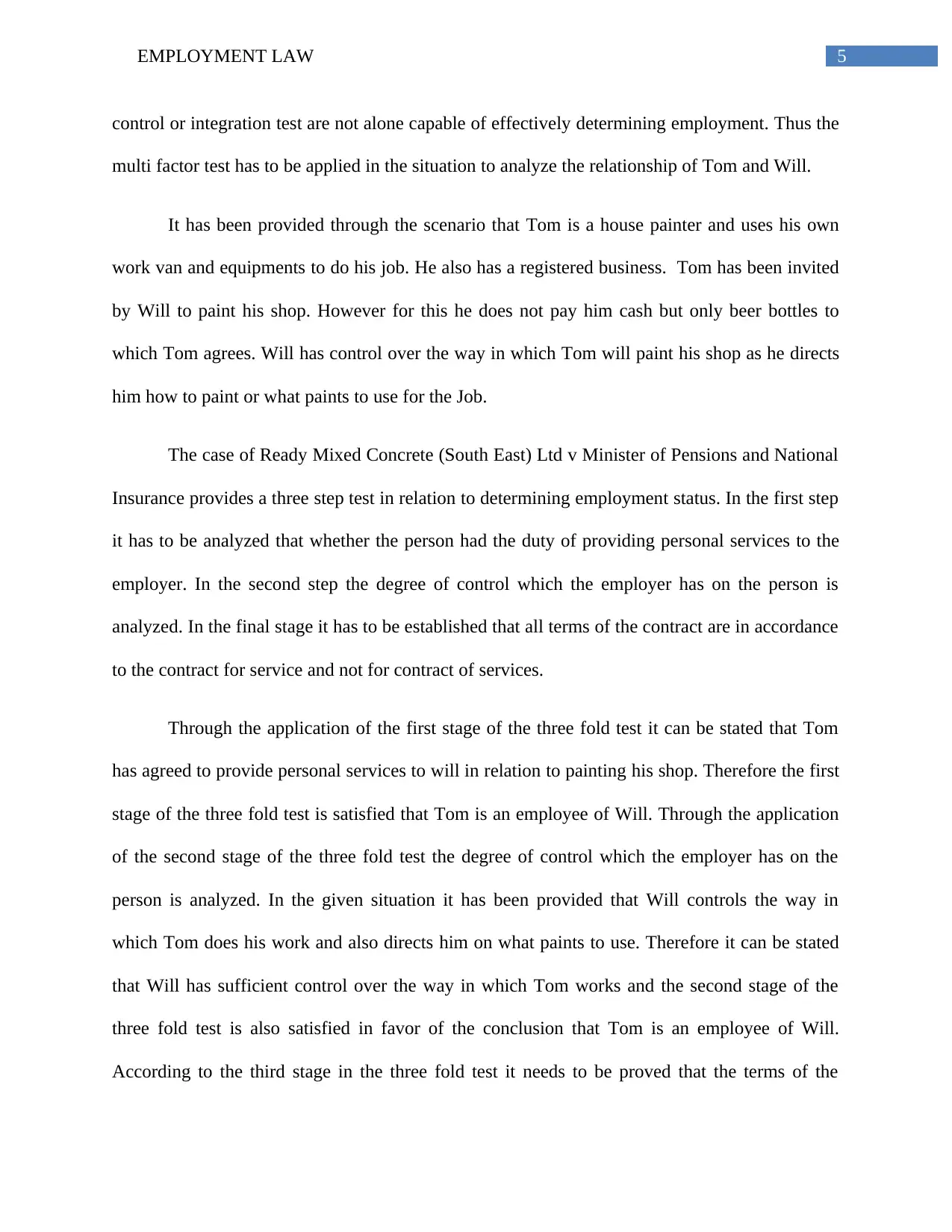
5EMPLOYMENT LAW
control or integration test are not alone capable of effectively determining employment. Thus the
multi factor test has to be applied in the situation to analyze the relationship of Tom and Will.
It has been provided through the scenario that Tom is a house painter and uses his own
work van and equipments to do his job. He also has a registered business. Tom has been invited
by Will to paint his shop. However for this he does not pay him cash but only beer bottles to
which Tom agrees. Will has control over the way in which Tom will paint his shop as he directs
him how to paint or what paints to use for the Job.
The case of Ready Mixed Concrete (South East) Ltd v Minister of Pensions and National
Insurance provides a three step test in relation to determining employment status. In the first step
it has to be analyzed that whether the person had the duty of providing personal services to the
employer. In the second step the degree of control which the employer has on the person is
analyzed. In the final stage it has to be established that all terms of the contract are in accordance
to the contract for service and not for contract of services.
Through the application of the first stage of the three fold test it can be stated that Tom
has agreed to provide personal services to will in relation to painting his shop. Therefore the first
stage of the three fold test is satisfied that Tom is an employee of Will. Through the application
of the second stage of the three fold test the degree of control which the employer has on the
person is analyzed. In the given situation it has been provided that Will controls the way in
which Tom does his work and also directs him on what paints to use. Therefore it can be stated
that Will has sufficient control over the way in which Tom works and the second stage of the
three fold test is also satisfied in favor of the conclusion that Tom is an employee of Will.
According to the third stage in the three fold test it needs to be proved that the terms of the
control or integration test are not alone capable of effectively determining employment. Thus the
multi factor test has to be applied in the situation to analyze the relationship of Tom and Will.
It has been provided through the scenario that Tom is a house painter and uses his own
work van and equipments to do his job. He also has a registered business. Tom has been invited
by Will to paint his shop. However for this he does not pay him cash but only beer bottles to
which Tom agrees. Will has control over the way in which Tom will paint his shop as he directs
him how to paint or what paints to use for the Job.
The case of Ready Mixed Concrete (South East) Ltd v Minister of Pensions and National
Insurance provides a three step test in relation to determining employment status. In the first step
it has to be analyzed that whether the person had the duty of providing personal services to the
employer. In the second step the degree of control which the employer has on the person is
analyzed. In the final stage it has to be established that all terms of the contract are in accordance
to the contract for service and not for contract of services.
Through the application of the first stage of the three fold test it can be stated that Tom
has agreed to provide personal services to will in relation to painting his shop. Therefore the first
stage of the three fold test is satisfied that Tom is an employee of Will. Through the application
of the second stage of the three fold test the degree of control which the employer has on the
person is analyzed. In the given situation it has been provided that Will controls the way in
which Tom does his work and also directs him on what paints to use. Therefore it can be stated
that Will has sufficient control over the way in which Tom works and the second stage of the
three fold test is also satisfied in favor of the conclusion that Tom is an employee of Will.
According to the third stage in the three fold test it needs to be proved that the terms of the
⊘ This is a preview!⊘
Do you want full access?
Subscribe today to unlock all pages.

Trusted by 1+ million students worldwide

6EMPLOYMENT LAW
contract between Tom and Will are predominantly in compliance with a contract for service
rather than a contract for services. In the given situation Tom is not provided weekly or monthly
remuneration by Will and is only being paid on a one time basis in form of the beer bottles. This
suggests that Thomas nearly an independent contractor as he is not provided with regular
remuneration. In addition it has been provided that Tom uses his own tools and van for the
purpose of completing the paint work. An employee is usually provided with tools and
equipments to do the work by an employer. Therefore in the given situation it can be stated that
the type of the contract between Will and Tom also indicates that Tom is an independent
contractor and not an employee. The facts of the case study further provide that Tom has a
registered business under which he operates the painting job. An employee cannot have a
registered business of his own and has to work under the control of the employer. Thus this
provision of the arrangement between Will and Tom also suggest that Tom is an independent
contractor rather than an employee. Thus through the application of the above discussed multiple
factor, 3 fold test it can be stated that Tom is not an employee of Will but rather an independent
contractor.
Thus through the application of the case of Prince Alfred College Incorporated v ADC it
can be stated that as Tom is not the employee of Will he cannot be held liable for the actions
which has been committed by Tom. The provisions of vicarious liability are only applicable
when it is proved that the person who has indulged induction is under the control of the
employer. In this case study it has been further stated that Will did not authorize Tom to be
drunk and go on a bicycle. The act has been committed by Tom against authorization provided
by Will therefore in the given situation Will cannot be held liable for the accident which Annie
contract between Tom and Will are predominantly in compliance with a contract for service
rather than a contract for services. In the given situation Tom is not provided weekly or monthly
remuneration by Will and is only being paid on a one time basis in form of the beer bottles. This
suggests that Thomas nearly an independent contractor as he is not provided with regular
remuneration. In addition it has been provided that Tom uses his own tools and van for the
purpose of completing the paint work. An employee is usually provided with tools and
equipments to do the work by an employer. Therefore in the given situation it can be stated that
the type of the contract between Will and Tom also indicates that Tom is an independent
contractor and not an employee. The facts of the case study further provide that Tom has a
registered business under which he operates the painting job. An employee cannot have a
registered business of his own and has to work under the control of the employer. Thus this
provision of the arrangement between Will and Tom also suggest that Tom is an independent
contractor rather than an employee. Thus through the application of the above discussed multiple
factor, 3 fold test it can be stated that Tom is not an employee of Will but rather an independent
contractor.
Thus through the application of the case of Prince Alfred College Incorporated v ADC it
can be stated that as Tom is not the employee of Will he cannot be held liable for the actions
which has been committed by Tom. The provisions of vicarious liability are only applicable
when it is proved that the person who has indulged induction is under the control of the
employer. In this case study it has been further stated that Will did not authorize Tom to be
drunk and go on a bicycle. The act has been committed by Tom against authorization provided
by Will therefore in the given situation Will cannot be held liable for the accident which Annie
Paraphrase This Document
Need a fresh take? Get an instant paraphrase of this document with our AI Paraphraser
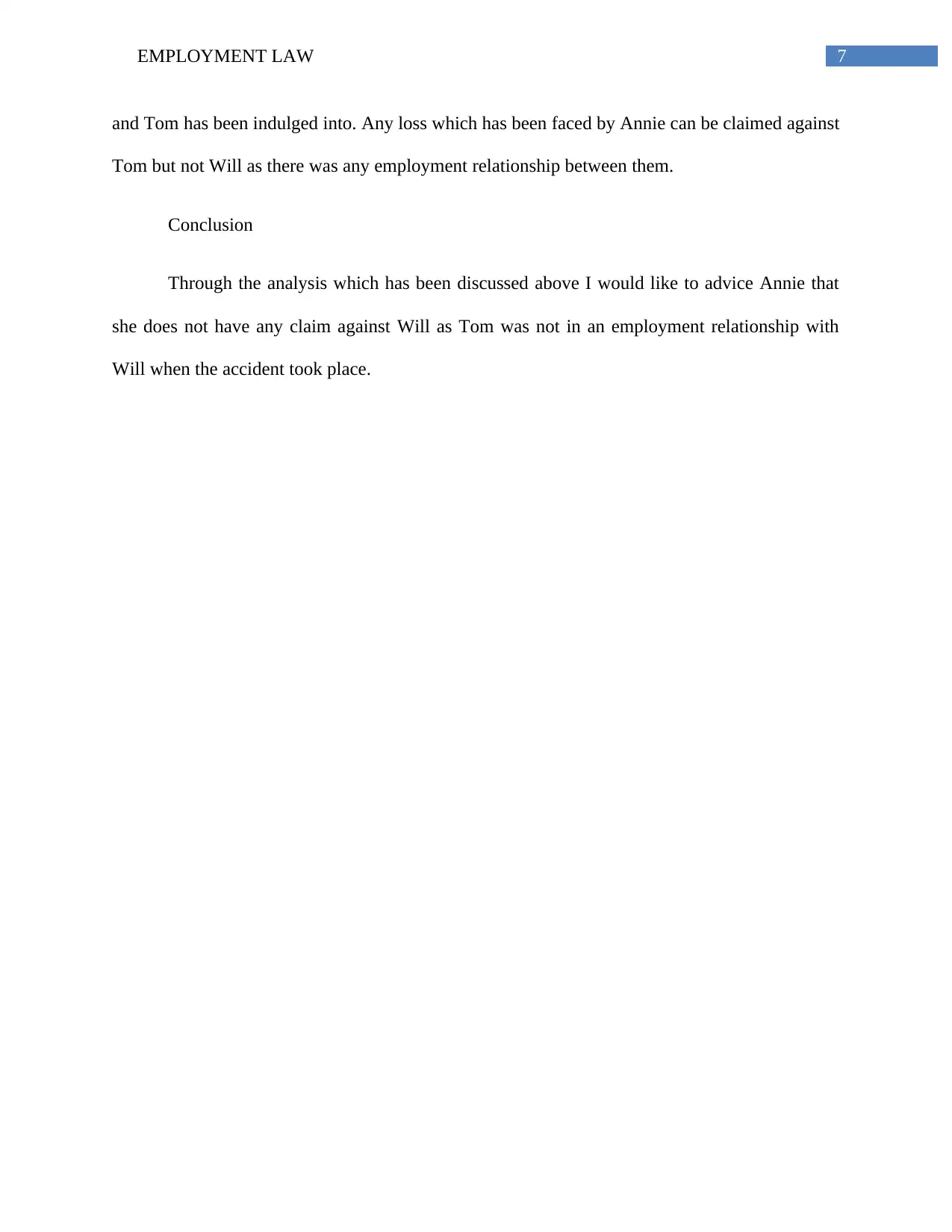
7EMPLOYMENT LAW
and Tom has been indulged into. Any loss which has been faced by Annie can be claimed against
Tom but not Will as there was any employment relationship between them.
Conclusion
Through the analysis which has been discussed above I would like to advice Annie that
she does not have any claim against Will as Tom was not in an employment relationship with
Will when the accident took place.
and Tom has been indulged into. Any loss which has been faced by Annie can be claimed against
Tom but not Will as there was any employment relationship between them.
Conclusion
Through the analysis which has been discussed above I would like to advice Annie that
she does not have any claim against Will as Tom was not in an employment relationship with
Will when the accident took place.

8EMPLOYMENT LAW
Bibliography
Cassidy v Ministry of Health [1951] 2 KB 343
Craven, Judith A. "The Employment Relationship." NY Practice Guide: Business and
Commercial 4 (2016).
Digby v The Compass Institute Inc and Anor 30 October 2015 [QSC 308]
Garrison, Joseph. "The New Restatement of Employment Law." Judicature 100 (2016): 30.
Holland, J. A., Burnett, S., & Millington, P. (2015). Employment Law 2016. Oxford University
Press.
Pioneer Mortgage Services Pty Ltd v Columbus Capital Pty Ltd [2016] FCAFC 78
Pipe Industries Ltd v Occidental Life Nominees Pty Ltd (1992) 10 ACLC 253
Prince Alfred College Incorporated v ADC [2016] HCA 37
Ready Mixed Concrete (South East) Ltd v Minister of Pensions and National Insurance [1968] 2
QB 497
Rose, Emily. "David Cabrelli, Employment Law in Context." (2016): 105-106.
Schipani, Cindy A., Frances J. Milliken, and Terry Morehead Dworkin. "The Impact of
Employment Law and Practices on Business and Society: The Significance of Worker Voice." U.
Pa. J. Bus. L. 19 (2016): 979.
Scott v Jackson Garden Landscape Supplies Pty Ltd [2015] QDC 018
Walsh, D. J. (2015). Employment law for human resource practice. Nelson Education
Bibliography
Cassidy v Ministry of Health [1951] 2 KB 343
Craven, Judith A. "The Employment Relationship." NY Practice Guide: Business and
Commercial 4 (2016).
Digby v The Compass Institute Inc and Anor 30 October 2015 [QSC 308]
Garrison, Joseph. "The New Restatement of Employment Law." Judicature 100 (2016): 30.
Holland, J. A., Burnett, S., & Millington, P. (2015). Employment Law 2016. Oxford University
Press.
Pioneer Mortgage Services Pty Ltd v Columbus Capital Pty Ltd [2016] FCAFC 78
Pipe Industries Ltd v Occidental Life Nominees Pty Ltd (1992) 10 ACLC 253
Prince Alfred College Incorporated v ADC [2016] HCA 37
Ready Mixed Concrete (South East) Ltd v Minister of Pensions and National Insurance [1968] 2
QB 497
Rose, Emily. "David Cabrelli, Employment Law in Context." (2016): 105-106.
Schipani, Cindy A., Frances J. Milliken, and Terry Morehead Dworkin. "The Impact of
Employment Law and Practices on Business and Society: The Significance of Worker Voice." U.
Pa. J. Bus. L. 19 (2016): 979.
Scott v Jackson Garden Landscape Supplies Pty Ltd [2015] QDC 018
Walsh, D. J. (2015). Employment law for human resource practice. Nelson Education
⊘ This is a preview!⊘
Do you want full access?
Subscribe today to unlock all pages.

Trusted by 1+ million students worldwide

9EMPLOYMENT LAW
Yewen v Noakes [1880] 6 QBD 530
Yewen v Noakes [1880] 6 QBD 530
1 out of 10
Related Documents
Your All-in-One AI-Powered Toolkit for Academic Success.
+13062052269
info@desklib.com
Available 24*7 on WhatsApp / Email
![[object Object]](/_next/static/media/star-bottom.7253800d.svg)
Unlock your academic potential
Copyright © 2020–2025 A2Z Services. All Rights Reserved. Developed and managed by ZUCOL.





